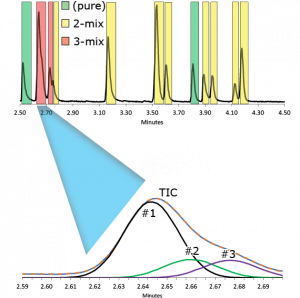Unlike most “conventional” deconvolution algorithms, which uses only a few resolved m/z ions to locate potential coeluting peaks (eXtracted Ion Chromatograms (XIC)), GC/ID uses a patented, “Full Spectrum” Deconvolution (FSD) approach for improved performance and accuracy. This is a multi-step process based on sound statistical methods.
- An initial “mixture” screening using Principal Component Analysis (PCA) is used to reliably estimate the number of “components” (compounds) included in a chromatographic peak or group of peaks. This step reduces the typical overfitting that can produce erroneous spectra and false IDs when using XIC based approaches. While the traditional deconvolution can work well, producing “false” spectra is detrimental to proper compound ID and confusing and/or misleading for the analyst
- Once the number of components is determined, peak modeling is done based upon number of components and the derived PCA scores (spectral vectors) to arrive at an optimized solution of:
- The position and area of the underlying pure component peaks
- The most likely spectra for the components
This approach has a number of advantages over traditional deconvolution:
- Superior quantitation of the underlying peaks using full spectrum fit since the full spectrum is integrated under the peak curve, not just a single ion, the best approach for the quantitative analysis of unknown compounds
- Automatic background correction is “free” due to the matrix algebra used as it become a static “residual”, no need to manually or automatically try to identify and subtract “baseline” spectra
Finally, any deconvolution math will fail if the compounds elute to closely. For these cases, Cerno’s Search Mixture Deconvolution (SMD) steps in to identify and resolves these cases.
Figure 1. “Full Spectrum” Deconvolution (FSD) automatically identifies mixture peaks and then quantitatively determines the peak positions and area of the underlying peaks. The pure spectra are then computed for each peak which can then be searched and processed. Unlike other technologies for peak mixture determination, FSD is fully automated, quantitatively accurate, and performs up to 10X better by considering the total ion current rather than a few spectral peaks.

